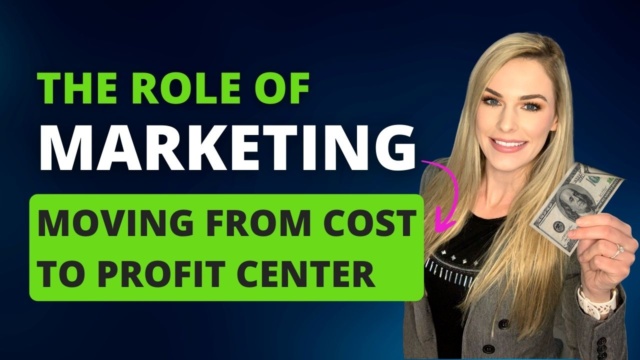I read an article recently where the CMO of UPS departed the company. Not only that, but UPS announced it would be eliminating the CMO position completely. Instead, they decided that marketing would be overseen by the newly promoted chief commercial and strategy officer. As a marketer with over a decade of experience, the lack of understanding of the role of marketing among the C-suite deeply concerns me. This news, coupled with the rising trend in the marketing space suggesting that there is an increasing lack of trust among CEO's in CMO's leadership, is not something to take lightly.
“Why is this concerning?” you may ask. A chief commercial strategy officer is typically responsible for the development and commercial strategies of a company to increase profits. The mind-bending issue here is that is exactly what a CMO should be doing. There is a fundamental misunderstanding among C-level executives on what marketing is accountable for. With only 1 in 10 CEOs having a marketing background, this isn’t exactly surprising.
Sadly, this disconnect is something I’ve experienced and witnessed first-hand throughout my career. If we don’t begin to address it, then marketing risks not having a seat at the table, and businesses risk losing one of their most important growth assets.
Below are a few very simple lessons that, as marketers, we need to understand in order to start changing this dynamic. And the change starts with us.
The Main Purpose of Marketing
There's been a crucial lesson that has stuck with me my entire career since college that I'd like to share with you. It's a piece of fundamental knowledge that I believe has not been learned by all marketers, contributing to the disconnect between marketing and the C-suite. And - that disconnect will continue unless marketing truly hones this lesson. So, after reading this, feel free to staple it on your cubicle wall, save it as your screensaver, make it into a t-shirt - whatever it takes.
The Professor’s Lesson
My professor stood in the front of the class, grinning. She went up to the whiteboard, marker in hand. "Can anyone tell me the main goal of marketing?" Students slowly started speaking up. "Brand awareness?" one student hesitantly offered. Another enthusiastically shouted - "Making sales!" The professor, seemingly unimpressed, scribbled these answers onto the whiteboard. "Anyone else?" she asked. I finally understood that grin...this question was not going to be a simple one. A few other students spoke up, answers ranging from "business growth" to "revenue generation." Now, looking fairly disappointed, our professor looked at the class and said, "None of these answers are correct." The energy rose as the class began to talk among themselves and even challenged the professor at this seemingly wild accusation. "But how is revenue not the ultimate goal of marketing?" one student challenged. "All of these answers are fine - but none are the MAIN purpose of marketing. You are missing one thing, and if you don't have it, none of you will keep a job." The professor wrote "PROFIT" on the board and circled it multiple times with her green marker. At that moment, I realized this was one of the most essential pieces of knowledge I would take away from my time in school.
Sales are important. Brand awareness is important. Everything the students mentioned is important, and marketing is responsible for all of these things. However, the company will eventually fail to exist if none of these things are profitable. Marketing needs to exist as a profit center.
Understanding Marketing as a Profit Center
Let's get super real here. Marketing is typically an overhead expense in the accounting world. However, marketing and sales are truly the ONLY profit-generating departments in a company. Marketing ignites consumer action and influences behavior. It brings in the sales, the clicks, and the engagement. Without marketing, there is no consumer action. There are no clicks, votes, or sales.

So what is a cost center, then? R&D and manufacturing are examples of cost centers. They are wildly important; however, you need skillful marketing to bring those innovations created in R&D and manufacturing to market. The company doesn't make any money if ideas from R&D don't make it to market. Makes sense, right? Well - then why is the C-suite not jumping up and down yet and pouring more money into marketing? Why did the CMO position get eliminated from UPS? That brings me to my next point.
Show Me the Money
As marketers, we must be good stewards of communicating the value we provide for organizations. This means the C-suite needs to know EXACTLY what we are doing to help grow the organization and how marketing contributes. As we know, good marketing generates profit; however, many C-suite executives think of marketing as fluff - fun social media posts and cute blog posts on a website. There is a chasm of knowledge that exists between marketers and the rest of the C-suite.
The ROI of Blog Posts and Butterflies
I joined an entrepreneurial organization towards the beginning of my career. The founder/CEO thought he wanted someone who could do a slew of marketing “activities”: post blog articles, create some social posts, write press releases, and set up Google Ads (btw, the stated budget was $5/day for keywords where the average CPC was actually around $20/click). There was also an avid belief that since the company had just hired a marketing manager (me), a marketing budget wasn’t going to be necessary. There was immediately a huge disconnect between what he thought the organization needed vs. what was actually needed that I would end up providing. By some grace of God, I ended up making wine out of water at this company (lord knows I also needed some wine), scoring meetings with massive players such as Google and Deloitte, all from strategic inbound and outbound marketing. We soon expanded, and I worked with the product and development team to launch 3 new product lines. I was absolutely killing it - or so I thought.
"CEOs who place marketing at the core of their growth strategy are twice as likely to have greater than 5 percent annual growth compared with their peers."
-Mckinsey
Excited about my achievements and contributions to the company, I mustered up the strength to discuss a raise. I brushed off my pants, sat down in the large executive visitors' chair in the CEO’s glass-paned office, and said, "I'd like to discuss a raise." I outlined all the activities I had accomplished over the past year, how hard I'd been working, the quality of the content I'd been outputting, and recapped the successful launch of our shiny new products. The CEO smiled at me and said, "That's cute - you want a raise for writing blog articles and posting on social media?" My stomach completely sank - how could he not recognize all of the work I'd put in and the sales I generated? This was the moment when I realized how huge a disconnect there was between me and the CEO. A blow to my ego - this was my first hard lesson in understanding that it was my responsibility to show the executive team the monetary value that marketing brought the company. Newly energized, I started working on pulling data and tying the ROI of our marketing efforts to sales.
So, what happened after that? Well, I was the victim of my own success - I got the raise and a lot more responsibility in growing other areas of the business. If you don't know how much revenue and profit you're contributing to the business, this is your wake-up call to start measuring it now (and getting it in front of the C-suite!).
A Well-Deserved Seat at the Table
I’ve been in organizations where the C-suite doesn’t think marketing needs to have a seat at the table. Why? There is a lack of understanding of marketing’s strategic value. It may have been that they have never experienced it during their careers - remember, only 1 in 10 CEOs come from a marketing background. Nonetheless, it will be difficult for marketing to provide their creative and strategic insights unless they are in the boardroom.
Marketers bring the insights of behavioral adoption to the table. They can bring the answers to the following questions that can help develop a more compelling offering:
- Who should we sell to?
- What price point do we need to sell at?
- Where should we sell the offering?
- When should we launch?
- Why would a consumer want to buy our offering?
- How should we position the offering?
- Is there real demand for our offering?
Marketers can also provide insight into features needed, UX/UI design, what competitors are offering, how to differentiate, what to consider for growth in the coming years, and so much more.
I’ve been at organizations where senior leadership simply hands marketing the offering after months (sometimes years!) of devising it behind closed doors, only for it to be a major flop because they didn’t solicit marketing’s insight. Maybe the features sucked. Maybe there was actually no real need for it in the market. It may seem obvious to get marketing involved, but sadly, this happens all the time.
A Time for Change
The fundamental misunderstanding of marketing's role, as witnessed by the dismissal of the UPS CMO and the lack of marketing representation in the C-suite, reflects a broader issue. It's not just about marketing being seen as an overhead expense; it's about a deep-rooted underestimation of its potential to drive growth and innovation. This scenario is not just concerning; it's a stark reminder of the disconnect between the potential of marketing and the perception of its value.
The journey ahead requires us to redefine and reassert the role of marketing within businesses. We must shift the narrative from marketing being a cost to an investment, from a department that merely supports sales to one that drives profitable growth and sustainable competitive advantage. This involves not just communicating what we do but, more importantly, demonstrating how our actions directly contribute to the bottom line. It's about showing that marketing is not just about "blog posts and butterflies," but about strategic decisions that shape the future of the company. Our role is to ensure that marketing is not an afterthought but a core consideration in every business strategy.
And ultimately, that change begins with us.
Christy Puller is a dynamic leader known for driving profit and revenue through innovative digital marketing strategies. She has built marketing functions from the ground up in both B2B and B2C sectors, scaled teams, and generated over 8 figures ARR and 40-60% YoY growth for multiple industries.
Passionate about SEO, PPC, content strategy, and team leadership, Christy has crafted international and domestic marketing strategies and developed top-tier marketing teams. Holding a Bachelor of Science in Marketing from the University of Central Florida and multiple industry certifications, Christy combines academic rigor with real-world success to empower businesses and mentor future marketing leaders.
Contact [email protected].
Do you want more business revenue?
Hey, I'm Christy Puller. I'm passionate about getting your business on the path to generating revenue through marketing.

About Christy Puller
With over 10 years of strategic marketing experience, Christy is a dynamic leader known for driving profit and revenue through innovative digital marketing strategies. She has built marketing functions from the ground up in both B2B and B2C sectors, scaled teams, and generated over 8 figures ARR and 40-60% YoY growth for multiple industries.










